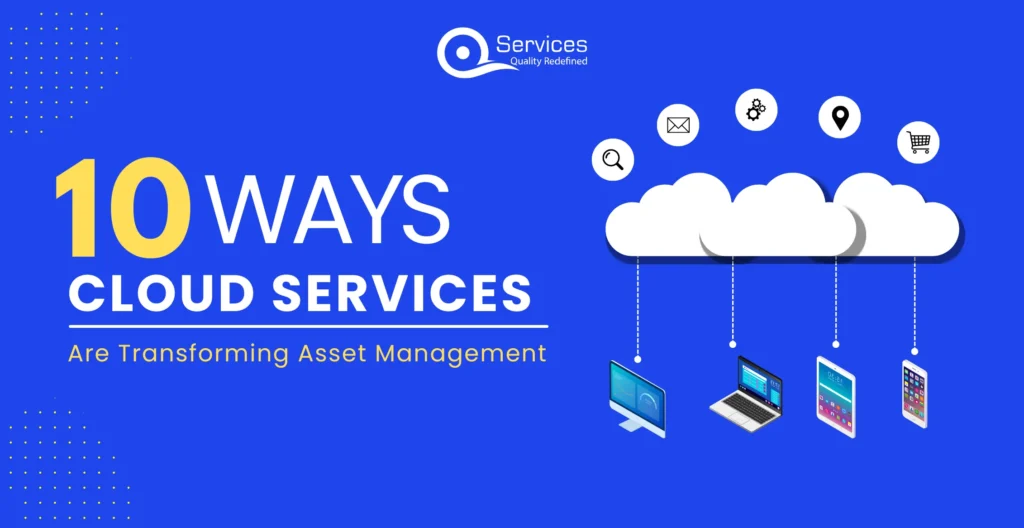Home » 10 Ways Cloud Services are Transforming Asset Management

Businesses are adopting cloud computing technologies at an increasing rate, with a particular focus on moving from traditional on-premises applications to cloud-hosted solutions. According to the statistics, half of an organization’s workload is now maintained on public clouds, demonstrating how widely cloud computing has become a standard feature of current company operations by giving access to advanced technologies. As consumers become more aware of the advantages of cloud computing, initial concerns about data security and management have diminished. The increasing prevalence of cloud-based services in daily life further drives the expansion of cloud computing. With its enhanced accessibility, scalability, and efficiency, cloud asset management transforms traditional asset management operations.
Cloud Asset Management(CAM) involves the systematic tracking and oversight of resources contributing to cloud service delivery. These assets encompass both tangible and intangible elements, such as virtual or physical storage, servers, software licenses, and staff expertise. Rooted in traditional asset management principles and aligned with established IT asset management cloud frameworks like ITIL, CAM ensures effective procurement, maintenance, and optimization of assets to support business objectives cost-effectively. While smaller companies may rely on spreadsheets for asset tracking, larger enterprises with extensive networks necessitate specialized asset tracking software to manage asset life cycles efficiently. CAM offers visibility and control over asset management in the cloud, optimizing cloud management processes and enhancing security. By managing components of cloud applications and ensuring smooth operation, CAM enables businesses to reduce costs and leverage the benefits of cloud infrastructure effectively.
Get free Consultation and let us know your project idea to turn into an amazing digital product.
Azure Cloud Services is a Platform as a Service (PaaS) offering within the Microsoft Azure cloud platform. It is designed to support applications in a scalable, reliable, and cost-effective manner, much like Azure App Service. Azure Cloud Services provide users with increased control over virtual machines (VMs), allowing for custom software installation and remote access. Within Azure Cloud Services, there are two primary roles: the Web role, which facilitates automated app deployment via Internet Information Services (IIS), and the Worker role, intended for running standalone applications. Despite relying on VMs, Azure Cloud Services prioritize the PaaS model over Infrastructure as a Service (IaaS), simplifying platform management and application deployment processes. Even AI is transforming Asset Management in various industries.
Cloud assets have become foundational for organizations pursuing digital transformation initiatives. Most companies now rely on public cloud services, often adopting a multi-cloud strategy for flexibility and reliability. for optimizing cloud usage, addressing cybersecurity concerns, and ensuring data privacy. It involves activities such as planning, acquiring, optimizing, and controlling costs of cloud assets, as well as ensuring compliance and regulatory adherence. Effective cloud asset management is essential for organizations to realize the full value of their cloud investments and succeed in their digital transformation efforts.
Moreover, cloud services are transforming asset management in various ways:
The process of consolidating all relevant asset data into a single, easily accessible repository is known as centralized data storage. Organizations can manage and keep track of several kinds of asset-related data, such as usage history, maintenance logs, equipment specifications, and associated paperwork, centrally in this repository. Businesses can use scalable and dependable infrastructure to host this centralized data storage solution by utilizing cloud services. By using this method, customers from all areas of the organization will have access to current and accurate asset information from any location with an internet connection.
Cloud services play a significant role in facilitating real-time monitoring for efficient asset management. These platforms enable users to access asset data anytime, anywhere, via web pages or mobile apps. Users can conveniently update and retrieve information using various devices, including desktops, smartphones, tablets, and laptops, regardless of their location—whether it’s within the workplace, across multiple sites, or in the field. Moreover, cloud-based asset management systems utilize IoT advancements for real-time asset tracking. IoT devices like Bluetooth receivers and RFID tags can be affixed to assets, allowing users to remotely retrieve data such as current location, condition, maintenance schedules, and usage details.
Mobile accessibility in cloud services has a transformative impact on asset management. Leveraging the cloud’s robust computing capabilities, asset management applications can achieve enhanced performance and user experience. By delegating resource-intensive tasks like data processing and storage to the cloud, these applications operate more efficiently, particularly on devices with constrained processing power and memory. Additionally, cloud-based caching and content delivery networks (CDNs) further mitigate latency, ensuring seamless and responsive user interactions and ultimately optimizing asset management processes.
cloud services provide adaptable infrastructure, enabling organizations to easily expand their asset portfolios and manage increasing data volumes without substantial initial expenditures. With cloud-based solutions, businesses can scale their storage and computing resources according to their evolving needs, avoiding the need for costly hardware upgrades or infrastructure investments. This scalability ensures that organizations can efficiently handle growing asset databases and data influxes, maintaining optimal performance and flexibility while reducing operational overheads associated with traditional on-premises infrastructure management.
cloud platforms facilitate smooth interaction and exchange of information among individuals or teams involved in managing assets. It emphasizes the real-time sharing of insights and updates, regardless of physical location or time differences, enabling efficient decision-making and fostering transparency. By leveraging cloud-based collaboration tools, organizations can tap into collective knowledge and expertise to enhance asset management processes, drive innovation, and achieve better outcomes overall.
Cloud-based asset management solutions utilize predictive analytics to optimize asset performance and reduce maintenance costs. These solutions utilize advanced analytics tools and machine learning algorithms to analyze historical data, identifying patterns and trends in asset behavior. By forecasting future asset performance, organizations can make proactive adjustments to maximize efficiency. Additionally, predictive maintenance recommendations based on data analysis help prevent unexpected failures, minimize downtime, and extend asset lifespan.
cloud services are transforming asset management through automation. By automating tasks such as inventory management, maintenance scheduling, and report generation, cloud-based systems reduce manual effort, streamline processes, and improve overall efficiency. This automation enables organizations to optimize their asset management workflows, minimize errors, and focus resources on more strategic initiatives, ultimately driving productivity and enhancing operational effectiveness.
By adopting cloud application development, businesses eliminate the need for on-premises infrastructure management. Cloud providers handle tasks such as networking hardware, data centers, and server maintenance, including software updates and security patches. With an affordable subscription model, businesses only pay for actual usage. Constant savings are achieved after deployment, considering hardware upgrades and energy usage are handled by third parties.
Asset management in cloud computing benefits from robust data encryption which ensures the security of sensitive information during transmission and storage. Cloud providers employ strong encryption techniques by safeguarding data from unauthorized access by encrypting it with decryption keys. Access controls further enhance security by regulating data access, permitting only authorized users to view, modify, or manage assets within the cloud environment. Additionally, compliance certifications such as ISO 27001, HIPAA, and PCI DSS validate adherence to industry standards and regulations, instilling trust in customers regarding the secure handling of their data within cloud-based asset management systems.
Cloud platforms effortlessly integrate with IoT devices to exchange data, enabling efficient asset management in the cloud. When assets such as machinery or vehicles are equipped with IoT sensors, they continuously generate real-time data, which is then transmitted to the cloud platform for analysis and processing. This integration offers several benefits for asset management. Firstly, predictive maintenance becomes possible as cloud platforms analyze real-time data to forecast maintenance needs, helping prevent breakdowns. Additionally, remote monitoring capabilities allow managers to track asset performance, receive alerts, and make informed decisions from anywhere.
Following appropriate security protocols and putting cost-efficient techniques into practice are all necessary for effective asset management in the cloud. Let’s examine the essential strategies that businesses can use to achieve operational excellence and optimize their cloud asset management procedures.
Centralized Asset Inventory
Maintain a comprehensive inventory of all cloud assets, including virtual machines, databases, applications, and storage. For example, keep track of all deployed instances of a cloud-based CRM system, along with their configurations and usage metrics.
Tagging and Categorization
Assign meaningful tags and labels to assets for better organization and management. For instance, tag cloud resources according to departments (e.g., marketing, finance) or projects (e.g., website redesign, product launch) to easily track costs and usage.
Resource Optimization
Continuously assess resource utilization to ensure efficient use of cloud resources like regularly review CPU and memory usage of virtual machines and adjust resource allocations accordingly to avoid over-provisioning.
Security Controls
Implement robust access controls to protect cloud assets from unauthorized access. For instance, restrict access to sensitive data stored in cloud databases to only authorized users with appropriate permissions.
Backup and Recovery Strategies
Establish automated backup schedules for critical data and applications hosted in the cloud such as set up daily backups of customer transaction data stored in a cloud-based database and regularly test the data recovery process to ensure timely restoration in case of data loss.
Cost Monitoring and Budgeting
Utilize cost management tools to track spending and stay within budget by monitoring usage and costs of cloud resources in real-time and setting up budget alerts to notify administrators when spending exceeds predefined thresholds.
Lifecycle Management
Define clear asset lifecycles, from creation and deployment to maintenance and retirement. Regularly review and update configurations of cloud assets to ensure compliance with security policies and industry regulations.
Compliance and Auditing
Monitor compliance with industry standards and regulations to ensure data protection and regulatory compliance. Conduct regular audits of cloud security controls and document compliance efforts to demonstrate adherence to regulatory requirements.
The rise of internet-connected devices has led to a surge in virtual assets hosted on the cloud, presenting a significant challenge for organizations seeking to maintain control and visibility. In response, cloud-based asset management software has emerged as a crucial solution, providing a holistic view of asset life cycles and automating processes from discovery to disposal.
Choosing the right asset management software is essential in navigating this complex terrain. It extends beyond simple asset tracking to encompass optimization, compliance, security, and cost reduction. This is where QServices a leading cloud application development services provider excels. Create cloud-native apps and services for Asset management with .NET and asp dot net development. With its platform, you can be confident that your assets are efficiently and effectively tracked and managed, regardless of the complexity or scale of your digital environment.

Content Moderator

Founder and CEO

Chief Sales Officer
